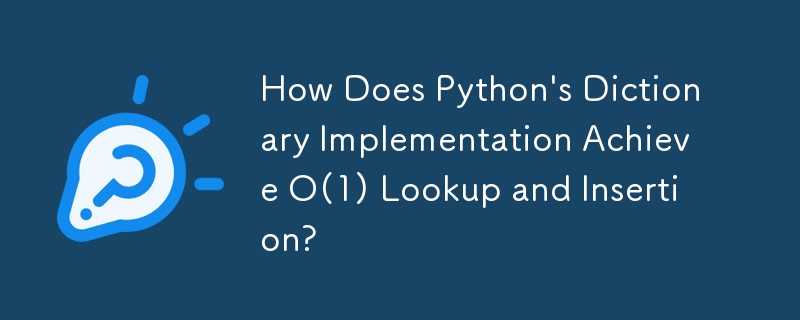 Backend Development
Backend Development
 Python Tutorial
Python Tutorial
 How Does Python's Dictionary Implementation Achieve O(1) Lookup and Insertion?
How Does Python's Dictionary Implementation Achieve O(1) Lookup and Insertion?
How Does Python's Dictionary Implementation Achieve O(1) Lookup and Insertion?

Demystifying Python's Dictionary Implementation: A Hashing Odyssey
Python's built-in dictionaries, a cornerstone of the language's capabilities, are implemented as hash tables. This efficient data structure enables O(1) lookup and insertion performance, making it ideal for rapid dictionary operations.
Under the hood, a Python dictionary is essentially a contiguous memory block organized into slots. Each slot can hold a single entry, a combination of a hash, key, and value. When adding a key-value pair to the dictionary, Python calculates the hash of the key, which determines the initial slot to check.
However, hash collisions are an inherent limitation of hash tables. Multiple keys can have the same hash value, resulting in an unavoidable conflict. Python addresses this by using open addressing, a technique where the next slot is checked until an empty one is found. This process is known as probing.
By comparing the hash and key values, Python ensures that the entry already exists before moving on if the initial slot is occupied. If not, the probing begins, exploring subsequent slots until an empty one is found.
On the flip side, lookups follow a similar process. The initial slot is calculated based on the key's hash. If the hash and key match, the entry is retrieved; otherwise, probing ensues.
It is worth noting that Python dictionaries are designed to resize when they reach a two-thirds capacity to maintain optimal lookup performance. This avoids undue slowdowns as the dictionary grows in size.
By understanding the intricacies of Python's dictionary implementation, developers can utilize the structure's efficiency, enabling rapid and efficient data storage and retrieval operations.
The above is the detailed content of How Does Python's Dictionary Implementation Achieve O(1) Lookup and Insertion?. For more information, please follow other related articles on the PHP Chinese website!

Hot AI Tools

Undresser.AI Undress
AI-powered app for creating realistic nude photos

AI Clothes Remover
Online AI tool for removing clothes from photos.

Undress AI Tool
Undress images for free

Clothoff.io
AI clothes remover

Video Face Swap
Swap faces in any video effortlessly with our completely free AI face swap tool!

Hot Article

Hot Tools

Notepad++7.3.1
Easy-to-use and free code editor

SublimeText3 Chinese version
Chinese version, very easy to use

Zend Studio 13.0.1
Powerful PHP integrated development environment

Dreamweaver CS6
Visual web development tools

SublimeText3 Mac version
God-level code editing software (SublimeText3)

Hot Topics
 How to avoid being detected by the browser when using Fiddler Everywhere for man-in-the-middle reading?
Apr 02, 2025 am 07:15 AM
How to avoid being detected by the browser when using Fiddler Everywhere for man-in-the-middle reading?
Apr 02, 2025 am 07:15 AM
How to avoid being detected when using FiddlerEverywhere for man-in-the-middle readings When you use FiddlerEverywhere...
 How to handle comma-separated list query parameters in FastAPI?
Apr 02, 2025 am 06:51 AM
How to handle comma-separated list query parameters in FastAPI?
Apr 02, 2025 am 06:51 AM
Fastapi ...
 How to solve permission issues when using python --version command in Linux terminal?
Apr 02, 2025 am 06:36 AM
How to solve permission issues when using python --version command in Linux terminal?
Apr 02, 2025 am 06:36 AM
Using python in Linux terminal...
 How to teach computer novice programming basics in project and problem-driven methods within 10 hours?
Apr 02, 2025 am 07:18 AM
How to teach computer novice programming basics in project and problem-driven methods within 10 hours?
Apr 02, 2025 am 07:18 AM
How to teach computer novice programming basics within 10 hours? If you only have 10 hours to teach computer novice some programming knowledge, what would you choose to teach...
 Python asyncio Telnet connection is disconnected immediately: How to solve server-side blocking problem?
Apr 02, 2025 am 06:30 AM
Python asyncio Telnet connection is disconnected immediately: How to solve server-side blocking problem?
Apr 02, 2025 am 06:30 AM
About Pythonasyncio...
 How to get news data bypassing Investing.com's anti-crawler mechanism?
Apr 02, 2025 am 07:03 AM
How to get news data bypassing Investing.com's anti-crawler mechanism?
Apr 02, 2025 am 07:03 AM
Understanding the anti-crawling strategy of Investing.com Many people often try to crawl news data from Investing.com (https://cn.investing.com/news/latest-news)...
 Python 3.6 loading pickle file error ModuleNotFoundError: What should I do if I load pickle file '__builtin__'?
Apr 02, 2025 am 06:27 AM
Python 3.6 loading pickle file error ModuleNotFoundError: What should I do if I load pickle file '__builtin__'?
Apr 02, 2025 am 06:27 AM
Loading pickle file in Python 3.6 environment error: ModuleNotFoundError:Nomodulenamed...
 What is the reason why pipeline files cannot be written when using Scapy crawler?
Apr 02, 2025 am 06:45 AM
What is the reason why pipeline files cannot be written when using Scapy crawler?
Apr 02, 2025 am 06:45 AM
Discussion on the reasons why pipeline files cannot be written when using Scapy crawlers When learning and using Scapy crawlers for persistent data storage, you may encounter pipeline files...





